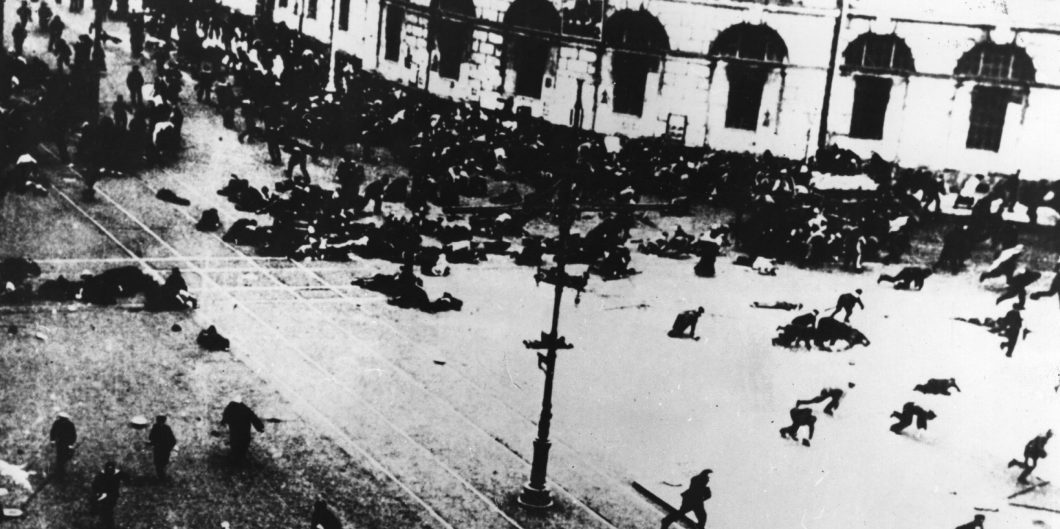Despite Gornick's good intentions, the painful end of the Communist romance dominates her book from start to finish.
Russian Revolution: A Bibliographic Tour
Thousands of books have been written about the revolution that erupted in Russia a century ago. For those seeking a quick and concrete entry into this subject, I offer a brief bibliographic selection based on the holdings of the Liberty Fund library. At Liberty Fund’s headquarters in Carmel, Indiana we are exhibiting a group of texts that illustrate some of the critical events and turning points—particularly those relating to the Bolshevik seizure of power and the civil war.
In March 1917 (February, according to the Julian calendar then in use in the Russian Empire) a revolution overthrew the 500-year-old Romanov dynasty and installed a provisional government dominated by left-of-center parties of liberals and socialists. Confronted by numerous challenges, the provisional government was overthrown barely eight months later in a coup d’etat organized and led by the Bolsheviks, a faction of the Russian Social Democratic Party.
The Bolshevik takeover in the so-called October Revolution (November in the Gregorian calendar) sparked a conflict that ended in 1922 with a Bolshevik victory and the establishment of the Union of Soviet Socialist Republics.
Readers would do well to start with a chronology of the Revolution from the classic The Formation of the Soviet Union (Richard Pipes, 1954). The book (and this chronology) focus on the Bolsheviks’ mostly successful efforts during the civil war to reconquer the non-Russian borderlands that broke away from the Empire after 1917.
The excellent Restless Empire: A Historical Atlas of Russia (Ian Barnes, 2015) contains well-designed maps giving a geographic overview of the primary events of the Revolution and civil war. Consulting these maps will give you an idea of the speed with which the Bolsheviks seized power in most of the major cities in the western part of the former Empire. You’ll also learn about the contested nature of the Ukraine and its surrounding territory. These would become the main battlefields of the civil war.
Next, we can consult the letter that Vladimir Lenin wrote to the members of the Bolshevik Central Committee on the eve of the coup. It can be found in Lenin on Politics and Revolution (editor James E. Connor, 1968). The All-Russian Congress of Soviets was scheduled to meet on October 25 (old calendar). Rather than wait and see what the Soviet would decide regarding the fate of the provisional government, Lenin urged an immediate takeover by force of arms.
“It would be a disaster, or a sheer formality, to await the wavering vote of October 25,” he wrote. “The people have the right . . . to decide such questions not by a vote, but by force.” The Congress convened late that same night and, as Lenin had suspected, many delegates were against a military solution to the problems with the provisional government. But it was too late for them: The Bolshevik-led assault was already well under way. At the Congress, Lev Trotsky issued his famous command that the defeated non-Bolshevik delegates go to the “dust bin of history.”
In Lenin: A Biography (Robert Service, 2000) there’s an interesting illustration of the Smolny Institute, a former girls school in Petrograd that had been the Bolshevik headquarters since July 1917. It was here, in classroom 36, that the “October Revolution” was planned. It was also here that the All-Russian Congress of Soviets met on the fateful night of 25-26 October “in the white-colonnaded ballroom, where the schoolgirls had once perfected their waltzes and polkas,” in the words of Orlando Figes.
The next set of images are taken from Figes’ magisterial A People’s Tragedy: The Russian Revolution (1996), and refer to the so-called “storming of the Winter Palace” by the Bolsheviks and their allies. The photographs give an idea of the defenses of the Winter Palace, the seat of the provisional government’s administration, on the eve of the Bolshevik attack. By the night of the coup most of the armed defenders of the Palace had already abandoned their positions, leaving a small group of Cossacks, some military cadets, and about 100 soldiers from the Women’s Battalion of Death left to confront the numerically superior Bolshevik force.
It turned out that the seizure of power was largely bloodless, resulting in fewer than a dozen people killed or wounded. As has been pointed out, more casualties resulted from the filming of Sergei Eisenstein’s October, produced for the 10th anniversary celebrations of the Bolshevik Revolution, than the storming of the actual Winter Palace.
While the Bolsheviks’ control of Petrograd did not result in anything like massive casualties, their enemies almost immediately began to organize armed resistance. Collectively known as the “Whites,” they represented a wide variety of ideological orientations. This was a major cause of their lack of unity, and constituted one of the main reasons for their ultimate defeat.
The Siberian Army was one of the main White forces. Under the command of the nominal leader of all the White armies, Admiral Aleksandr Kolchak, it launched a major offensive against the Red Army in the Spring of 1919. After some initial successes, the Red Army counterattacked and by the autumn had completely defeated the White forces in Siberia. Kolchak was captured and subsequently executed.
Despite aid from Western governments, the rampant corruption and poor administration that characterized Kolchak’s haphazard administration, as well as its isolated geographic position in Omsk (thousands of miles west of Vladivostok, its main source of supplies) resulted in poorly clothed and equipped soldiers—as can be seen in photographs from Sean McMeekin’s The Russian Revolution: A New History (2017).
An Illustrated History of the Great October Socialist Revolution (Albert Pavlovitsj Nenarokov, 1987) displays, among other compelling materials, a representative recruiting poster for the Red Army. Established in January 1918, the Red Army was initially made up of volunteers. As the civil war ground on, however, volunteers could not provide enough recruits and conscription was introduced in the summer of 1918. Hostages were often taken from the conscripts’ villages to discourage desertion.
The Revolution and civil war, as well as the seizure of grain from the peasants by Bolshevik officials, led to famine in most of the Volga and Ural regions of Russian in 1921 and 1922. In September 1921, Herbert Hoover of the American Relief Administration sent a team led by former Indiana Governor James Goodrich (father of Liberty Fund’s founder, Pierre Goodrich) to assess the situation and organize initial relief efforts. James Goodrich’s involvement is described in detail in Dane Starbuck’s 2001 book The Goodriches: An American Family. At the peak of its activities, during the summer of 1922, the ARA was feeding 10 million people a day in the stricken areas. Despite these efforts, approximately five million people perished during the famine.
By the end of 1920, the Red Army had emerged victorious over the last of the White forces in the south and so the economic and social conditions in the Ukraine could begin slowly to recover. At least as important were the reforms establishing the “New Economic Policy” in 1921. The NEP abandoned the destructive policies of food requisitioning and collectivization, substituting limited private property rights in agricultural land and regulated free trade in food and food stuffs. The NEP significantly expanded food production in the USSR. It was abruptly cancelled by order of Josef Stalin in 1928, however, and speculation has raged ever since about what would have happened if the policy had been allowed to continue.



